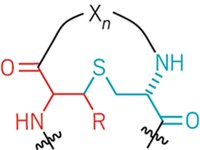Advertisement
Grab your lab coat. Let's get started
Welcome!
Welcome!
Create an account below to get 6 C&EN articles per month, receive newsletters and more - all free.
It seems this is your first time logging in online. Please enter the following information to continue.
As an ACS member you automatically get access to this site. All we need is few more details to create your reading experience.
Not you? Sign in with a different account.
Not you? Sign in with a different account.
ERROR 1
ERROR 1
ERROR 2
ERROR 2
ERROR 2
ERROR 2
ERROR 2
Password and Confirm password must match.
If you have an ACS member number, please enter it here so we can link this account to your membership. (optional)
ERROR 2
ACS values your privacy. By submitting your information, you are gaining access to C&EN and subscribing to our weekly newsletter. We use the information you provide to make your reading experience better, and we will never sell your data to third party members.
Biological Chemistry
To Tell Substrates Apart, Enzyme Switches Reactions
Strategy distinguishes a one-atom difference
by Carmen Drahl
November 19, 2012
| A version of this story appeared in
Volume 90, Issue 47
To distinguish two substrates that differ by just one atom, a bacterial enzyme takes an unusual tack, chemists report (Proc. Natl. Acad. Sci. USA, DOI: 10.1073/pnas.1212591109). The enzyme, a thioesterase, subjects the two compounds to different reaction pathways, in contrast to the typical strategy of relying on subtle differences in binding. The work could hold broader lessons for biocatalysis. In the course of forging carbon-fluorine bonds, the microbe Streptomyces cattleya makes the toxic compound fluoroacetyl-CoA. Its thioesterase must dismantle the toxin while sparing acetyl-CoA, an essential metabolite. Intrigued by the enzyme’s selectivity, University of California, Berkeley, chemists Amy M. Weeks and Michelle C. Y. Chang performed kinetics experiments. They found that the enzyme subjects acetyl-CoA to a conventional hydrolysis reaction at the carbonyl group. But the enzyme selects for fluoroacetyl-CoA by hydrolyzing it far more quickly and through deprotonation at the carbon adjacent to the carbonyl. The researchers think the rapid pathway proceeds through a ketene intermediate (shown). If follow-up experiments with isotope labels confirm that suspicion, it would be among the first reported examples of a ketene intermediate in enzyme catalysis with a natural substrate, Chang says.




Join the conversation
Contact the reporter
Submit a Letter to the Editor for publication
Engage with us on Twitter